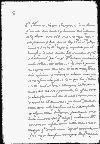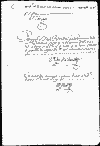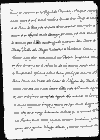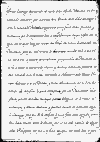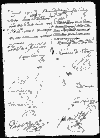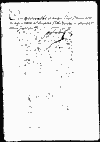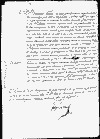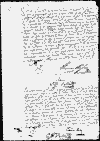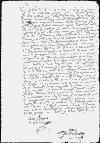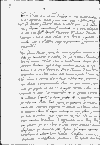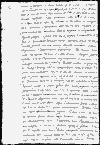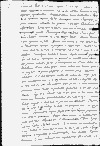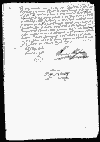
4.207
Hassett, Father Thomas
Processes in the provision of one of the two canonries of the Cathedral Church of New Orleans in regard to Father Thomas Hassett.
--------
1795 ? ?
Hassett, Father Thomas
to Bishop Luis Penalver y Cardenas
(New Orleans)
1.) Father Thomas Hassett former Pastor Vicar of St.
Augustine of Florida, encloses, with his petition to Bishop
Penalver y Cardenas, two documents: a.) The Royal Mandate, dated
Aug. 14, 1794, in virtue of which His Majesty presents Father
Hassett for one of the two canonries of the Cathedral Church of New
Orleans. b.) A pledge to pay the half of an annate. (The two
documents are presented later on).
2.) Moreover Father Hassett states that he is to make
application within the legal time and that he has only to prove:
a.) That he has not been expelled from any religious order, and
for proof of this he offers the certification of two, three or more
witnesses. b.) That he does not have any benefice incompatible
with the one he seeks.
3.) Furthermore, he asks the Bishop: a) for the canonical
collation. b) That, after he has made his profession of faith, the
legal possession may be granted him. Signed by Thomas Hassett.
--To this is added a note signed by the Bishop certifying that the
royal order and the pledge have been presented on Aug. 29, 1795 and
that he orders the three witnesses to appear.
--To this is added a note by Joseph Maria de Rivas as secretary
certifying that the above decree was issued and signed by the
Bishop on Sept. 4, 1795.
--Another note is added by Rivas certifying that on the same day he
notified Father Hassett of the above decree.
--------
1794 Aug. 14
Charles IV, King of Spain
to Bishop Luis Penalver y Cardenas
(New Orleans)
1) The King, reminds the Bishop that the right of patronage
belongs legally to him and that his right has been recognized by
apostolical bulls. In virtue of this privilege: a) He has the
right to present the candidates for the dignities, the canonries
and the ecclesiastical benefices both in the Peninsula and in the
Indies. b) He has also the right to set up new dioceses and divide
them, when he judges it convenient, with the proper dignities and
prebends. c) That in the particular case of Louisiana he has
decided after consulting the Council of Chamber of Indies on Oct.
22, 1792 to found the Bishopric of Louisiana with only two
canonries, each one of them having the annual rent of 600 pesos. d)
These amounts will be paid by the bishoprics of Mexico, Puebla de
Los Angeles, Valladolid de Mechoacan, Caracas and Havana. For that
purpose schedules have been sent to their Prelates, dated Nov. 23,
1793, in order that they may understand their obligation. 3.)(?)
That after having consented on Dec. 18, 1793, the Council of the
Indies, the King presents Father Thomas Hassett for the above
mentioned canonry. Moreover, the King asks the Bishop to examine
in conscience the merits of Father Hassett.
2) Moreover the King orders that: a) Father Hassett must
come in person before the Bishop of Louisiana within two months
from the date on which he is notified of the present decree by the
Bishop. b) Hassett must give guarantee of the payment of the half
an annat within the time allowed. c) Finally he has to prove that
he was not expelled from any religious institution and does not
have any dignity, Canonry of Benefice in the Indies, or that, if he
has had, he has already resigned them.
3) Moreover if the Bishop does not act according to the
King's will, the appointment will be considered as null.
4) Finally, His Majesty commands this order to be written
down in the general auditorship of the Distribution of the
Exchequer and in those of the Council of Indies, both in the
Peninsula and in New Orleans, with the guarantee of the payment of
the half an annat, otherwise this grant to Father Thomas Hassett
will be considered as null. Signed by the King.
--To this is added a certification by the Secretary of the King, D.
Antonio de Viutura Taranco, that by royal order he caused the above
decree to be drawn up.
--Another note certifies the receipt of 180 reales de peseta.
--Another note is added certifying the presentation of Father
Hassett for the second of the two canonries of the Bishopric of
Louisiana and Florida, and that the (Marquis of Bajamar, Bernardo
Triarte and Josef de Cistud have been consulted.
--Other certifications of the course of the royal process follow.
A copy of the royal order has been made in the general auditorship
of the distribution of the Exchequer. Dated Sept. 10, 1794,
Madrid. This is certified by Lorenzo de Vioz because of occupation
of the general Auditor.
--It is countersigned by Juan August de Cerain, lieutenant of the
high Chancellor. Twelve "reales de Peseta" were charged as rights.
this document is sealed.
--To this document is added a certification, dated Aug. 29, 1795,
New Orleans, that the Bishop Penalver y Cardenas received the royal
order about Father Thomas Hassett and ordered it to be delivered to
father Hassett who arrived today at New Orleans in order to
expedite the process. This is signed by the Bishop and witnessed
by Rivas as Secretary.
--another note is added by Francisco Rendon, Sept. 1, 1795, New
Orleans, certifying that a copy of the royal order will be placed
in both the general auditorship of the Army and the Exchequer of
this Province.
--Finally another note is added by Joseph de Orue, dated as above,
certifying that a copy of the royal order was placed in both the
general auditorship of the Army and the royal Exchequer under his
charge.
--------
1795 Sep. 1
Karric, Santiago
to Jose De Orue in behalf of Father Thomas Hassett
(New Orleans)
1) D. Santiago Karric, neighbour and a merchant at New
Orleans, obliges himself to answer to the Exchequer for the payment
of the half an annat or three hundred "pesos" which must be paid by
Father Hassett.
2) The time to pay is two years after Father Hassett enters
into possession of the canonry.
Signed by Thomas Hassett and Santiago Karric.
--To this is added a decree, dated as above, by Francisco Rendon in
which he approves the above obligation and pledge in behalf of the
Exchequer.
It is signed by Rendon and Orue certifying his intervention.
--Another note, dated as above, is added in which Jose Orue
certifies that the above document is a copy of the original and
that it has been made to be delivered to father Hassett for his
ends.
--------
1795 Sep. 4
Father Thomas Hassett
presents the following witnesses:
1) Patrick Walsh appears before Bishop Penalver and testifies
that: a) Father Hassett studied in the Royal Irish college of
Salamanca in whose Dioceses, that of Valladolid and Sejovia, he was
ordained. b) Father Hassett was never a religious nor has been
expelled from any community. c) Father Hassett has not (?) other
office in the church but that of Pastor of St. Augustine of
Florida.
--The document is signed by the Bishop and Patrick Walsh and
notorized by Joseph Maria de Rivas as secretary.
Immediately, Father Hassett presented as witnesses the captain
Antonio argote who, besides certifying to some facts as above,
testified that: a) he had known Father Hassett since 1783 when the
latter was sent, with the approval of His Majesty, to Philadelphia,
the capital of Pennsylvania, to set up a primary school. b)
Hassett does not have any dignity, canonry or benefice in the
Indies.
--This is signed by the Bishop, Antonio Argote and notorized by
Rivas.
Immediately Father Hassett presented as witnesses D. Carlos
Ximines, native of St. Augustine, a notary public and neighbour of
this town, who besides certifying to same facts as above, declared
that he had known Father Hassett since 1791 or 1792 in the Island
of Cuba. This is signed by the Bishop, Carlos Ximenes and
notorized by Rivas.
--------
1795 Sep. 5
Penalver y Cardenas, Luis
(New Orleans)
The Bishop announces:
1.) That Father Thomas Hassett was proposed by the King of
Spain in his royal order of Aug. 14, 1794 San Ildefonso, to occupy
one of the two canonries of the Cathedral Church of Louisiana with
the annual rent of 600 "pesos."
2.) That Father Hassett, whom the Bishop has known since
1770, fulfilled all the requisites for occupying the above
mentioned prebend by: a) The testimonial proof and notoriety: b)
by arrangement for the payment of the half an annat.
3.) That in view of these facts, the Bishop decrees that in
obedience to the royal order, he granted Father Hassett the
canonry.
4.) Furthermore, the Bishop ordains that Father Hassett
appear before him: a)to make the declaration of faith and the oath
of fidelity; b) to receive afterwards the canonical collation and
get possession of the Benefice; c) so that he will have the right
to the annual rent with all the emoluments.
--Signed by the Bishop and witnessed by Rivas.
--------
1795 Sep. 7
Certification that Father Thomas Hassett has received the
collation of his office from Bishop Penalver y Cardenas.
The ceremony took place in the Cathedral church of New Orleans
before the following witnesses: Fathers Patrick Walsh, Ramon Palao
and Isidro Quintero and many other persons.
The canonical collation comprehends the following parts: a)
The protestation of faith and the oath of fidelity. b) The
Symbolical collation. c) The real possession of the chair Father
Hassett will occupy in the choir of the cathedral.
The Protestation of Faith:
Before the Bishop Penalver sitting in his episcopal chair of
the Cathedral Church, canon Hassett, on his knees, made his
declaration of faith. This declaration contains the whole Nicene
Creed; the doctrine of the Church about the Sacraments, the
apostolical traditions, the Holy Scriptures; about the declarations
of the Tridentine council, the sacrifice of the Mass and the
transubstantation; about the Purgatory, etc. In fine, Father
Hassett pledges to believe and teach all the Church believes and
teaches.
The Oath of Fidelity:
Father Hassett swears: a) to obey the mandates of the Church.
b) Not to oppose directly or indirectly the rights of the Church.
c) Obedience to the occupant of the Holy Church of Louisiana and to
all his legitimate successors. d) That he will not act against the
capitulars or enter into any conspiracy. e) That to obtain this
prebend he will defend the mystery of the Immaculate Conception.
g) That he will not teach even under the title of probability the
bloody doctrine of regicide and tryannicide.
The Symbolical Collation:
Afterwards the Bishop made the Symbolical Collation by putting
a biretta on the head of Father Hassett who kissed the episcopal
ring in signal of gratitude.
Signed by the Bishop.
--To this is added a note by Rivas certifying the he was present to
all that took place and caused a copy to be made by the Bishop's
order.
The real possession:
1) Immediately after and in the same cathedral church, Bishop
Penalver gave Father Hassett the real possession of the prebend.
2) Ceremony. The Bishop took Father Hassett by the hand and
gave him possession of the chair of the choir of the Cathedral,
sitting him down and standing him up as a sign of the possession
without encroachment on the rights of Father Francisco Peres
Guerrero, the other canon of the Cathedral.
Signed by the Bishop, Father Hassett and witnessed by Rivas.
IV-5-b D.S. 20pp. 4to. (Spanish)
9

